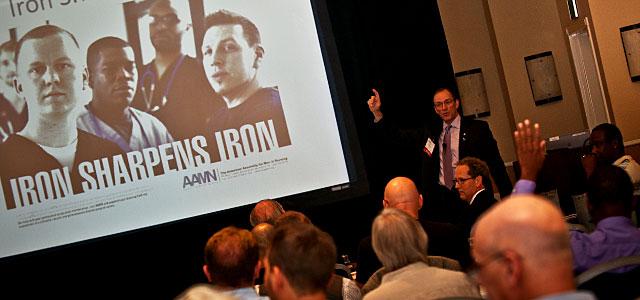
William Lecher speaks at the American Assembly for Men in Nursing's 37th annual conference, hosted by UCSF (photo by Elisabeth Fall).
Manpower
Working in the psychiatric unit at a Bay Area hospital, Brian Whiteside often enjoys moments that affirm his love of nursing. They usually come when he’s with a patient waking up from a nightmare of delusions.
Once Whiteside was sitting with a young man who had spent the previous few days removing his clothes and behaving in a scattered, agitated way, but who now was calm. Clarity came into the man’s eyes as he listened to Whiteside explain the circumstances that brought the man to the hospital.
The medications were probably taking effect, but Whiteside, an RN in his second year in UCSF’s Master’s Entry Program in Nursing (MEPN), believes the care he and the other nurses provided helped the patient feel safe.
“I don’t know why it was so sudden in his case, but it was quite a profound reminder of why I chose nursing in the first place,” says Whiteside, who is specializing in psychiatry and mental health. He says it’s possible that his gender and friendly, collegial manner created a rapport – two men talking – that helped the patient feel less alone. During the rest of his stay, the man never relapsed into psychosis, and as far as Whiteside knows, the man has since returned to college and is managing his illness.
Missing Men
Helping others is the primary reason anyone goes into nursing, but today men make up less than 7 percent of the US nursing workforce of 3 million. That percentage has more than doubled since 1980, but nurse leaders say men are still wary of a profession that many in society and health care view as women’s work.
This perception keeps men from a professional path that offers one of today’s best job opportunities, economic stability and upward mobility. It also could hurt the future of patient care.
The landmark 2010 Institute of Medicine report, The Future of Nursing: Leading Change, Advancing Health, states that men bring unique skills and perspectives to the profession, including life experiences, more traditionally masculine communication styles and the simple fact that they “look like” half the patient population, says David Vlahov, who became the first male dean of UCSF’s School of Nursing in early 2012.
Recruiting more men to nursing serves a larger goal of increasing diversity in the workforce and addressing projected nursing shortages following the passage of the 2010 Affordable Care Act.
The American Assembly for Men in Nursing (AAMN) wants to boost men’s numbers to 20 percent of all students enrolled in nursing programs by 2020. But, at the organization’s annual conference in October, speakers outlined obstacles to recruiting and keeping men in schools and on the job.
These obstacles include stereotypes that nursing lacks prestige and is less “manly” than being a doctor; men feeling unwelcome in schools and in care settings; concerns about appropriate ways for men to touch patients; and ambivalence among men and other professionals about how men can express their compassionate, nurturing sides.
Overcoming Stereotypes
“It all starts with the fact that nursing is a female-dominated profession,” Vlahov says.
Female nurses certainly dominate the popular imagination. The image of the nurse in a starched white dress and cap may have waned in recent decades, but the nurses of TV shows and movies are invariably female; when they’re not, they are often the butt of jokes, as Ben Stiller’s character was in the Hollywood comedy Meet the Parents.
“Kindergarten, first and second grade boys and girls regularly report that only mothers can be nurses, not fathers,” says William Lecher, the president of the AAMN.
Josie Clevenger, the outreach coordinator for the Coalition for Nursing Careers in California, regularly goes into Bay Area middle and high schools. Most of these schools serve low-income students. “When I asked kids if they are thinking about pursuing a career in nursing, the girls’ hands shoot up. Later, after the other kids have left, a few boys will come up to me to ask me questions about nursing. But they don’t want their friends to see them.”
UCSF’s Whiteside certainly never conceived of becoming a nurse growing up. He even brushed off suggestions to consider nursing after he graduated from UC Santa Cruz in 2006 with a bachelor’s degree in psychology.
“I think a lot of it was because I was a man,” he says. “It just wasn’t in the realm of possibility of what I wanted to do.”
Like many in the general public, he assumed nurses just emptied bedpans and performed other menial tasks. That changed when he was a counselor in the psychiatric unit and saw his nurse colleagues managing the department and making crucial decisions about patient care. Seeing them demonstrate leadership helped Whiteside realize he didn’t need to tear up his “man card” when he became a nurse.
Another challenge is that some cultures cling to traditional gender roles, says former MEPN student Adrian Espinosa, who graduated from San Jose State University with degrees in biology and public health. His Latino family may have been atypical because they offered unconditional support when he announced he was going to go to nursing school after working seven years in public health. “They caught me off guard when they said I would be perfect as a nurse,” he says.
Like most men interviewed, Espinosa had no male role models in nursing when he was younger. He seriously considered medical school first. The person who showed him that nurses can offer patients both medical expertise and compassionate one-on-one attention was the female cousin who helped care for their dying grandmother. Espinosa hopes to become a family nurse practitioner.
A Hidden History
Men versed in nursing’s history shake their heads at how far nursing has fallen in men’s esteem. For centuries, nursing was man’s work.
Various accounts describe men working as nurses in ancient Rome and India, and becoming fixtures of military and religious orders in early Christianity through the 16th century: from the Teutonic Knights to the Benedictines to the Alexian Brothers. Male surgeon’s mates and hospital attendants provided critical services to the Continental Army during the Revolutionary War, and enlisted men provided frontline care during the Civil War.
Then came Florence Nightingale in the mid-19th century. She is a contentious figure for men. While they praise her for raising standards of education and practice, they also say she discouraged men from the profession when she famously banned them from her wards, saying their “hard and horny hands” were not fit to tend the sick and injured.
Through the 20th century, nursing became synonymous with women’s work as it became one of the few careers open to females. Men interested in health care pursued higher-paying careers as physicians or scientists.
Fighting for Acceptance
When he entered nursing school in the late 1970s, Austin Nation, a second-year PhD student at UCSF, was one of several males in classes surrounded by female students. He likens his experience to early female students entering medical schools.
Some female faculty members were openly hostile. “There was a faculty member who asked me when I first met her, ‘What are you doing here? You’re never going to be a nurse.’” Being African American in a mostly white classroom added to his sense of isolation.
“At my community college, I started with a class of 120. I remember maybe five guys. But people would drop off every quarter,” he says.
For a long time, nursing textbooks used female pronouns, says Hilliard Pettus, the patient care manager at UCSF Medical Center, who first went to nursing school in the late 1980s. Fortunately, that’s getting better, he says.
What’s slow to change is the dismissive and even discriminatory behavior men encounter in their day-to-day school and work lives. Studies suggest that recruiting men to nursing schools actually isn’t the biggest problem. It’s keeping them in schools and in jobs where they believe their perspective is valued.
For nursing students, regrettably, that isn’t always the case – especially in a clinical rotation like labor and delivery.
“As soon as I arrived for my six-week OB rotation, it was clear that men were not wanted,” Pettus says about his experience as an RN student in the late 1980s, when he was one of five men in a class of 50. The nurses had to check new mothers’ breasts for lactation complications and vaginal areas for postbirth healing, and there was some clear discomfort with Pettus performing the procedures. The fact that no one balked when male doctors performed these procedures still mystifies him.
Bob Patterson, co-founder and immediate past president of the AAMN Bay Area chapter, says that while he was in school, a female physician asked the administration to ban men from the labor and delivery units. Patterson surmises the physician may have assumed female patients were uncomfortable with male nurses, but she need not have been worried. “The husbands and wives loved us,” he says.
In his entire career, Patterson says he had only one female patient tell him she was uncomfortable with a man tending her. That elderly patient stated, “It’s nothing personal. I just come from a different generation.”
Finding the Right Touch
In addition to feeling unwelcome in certain clinical rotations, other issues continue to challenge and frustrate men through nursing school and once they start work. For one thing, how male nurses touch patients has become a sensitive subject amid growing awareness about sexual harassment.
Nation says touch is essential to nursing and to how he interacts with patients, but he also wants to respect their personal space. There were times he second-guessed himself and became overly concerned that, as a 6-foot, 2-inch tall man, his physical size could be perceived as threatening by some patients. “We still don’t know how to teach this subject,” he says.
The data suggest that state boards discipline male nurses at disproportionately higher rates than women. The reasons remain elusive without more research, but the trend could deter men from entering and staying in the job, says Jennifer Ellis, an assistant professor at the University of Cincinnati’s Blue Ash College, who spoke at the AAMN conference.
Overall, nursing schools and workplaces struggle with how to let men – conditioned by nature or society to be “strong, silent types” – embrace their own way of expressing care and empathy.
Chad O’Lynn, co-editor of the book Men in Nursing: History, Challenges, and Opportunities, says in an interview on Medscape.com: “Caring is an art, and there are different ways of showing it.”
Whereas women often show caring in maternal ways – leaning close and speaking in a low voice, men sometimes are more apt to show it in a friendly, buddy way – joking and teasing, O’Lynn says. Both styles are equally valid, depending on the patient’s needs. When it comes to physical contact with patients, men should be confident but always gentle and let patients know when and how they will touch them.
Unlike some of his peers, Espinosa says his recent experience in labor and delivery was positive. He credits that to training he received in classes and to staff, including the floor nurse on his first day.
His first patient was a woman in active labor. “I was a little nervous in this intimate setting,” he says, but any embarrassment lifted as the mother got to work pushing and gave birth to a healthy boy. “I still remember being there and seeing this little human being come out of his mother and start to breathe.”
Like other men interviewed, he accepts that some patients will be put off by his gender. Some female patients, for example, prefer to see female physicians. But just as his fluency in Spanish gives him a way to communicate with non-English-speaking patients, his gender can help him relate to patients who respond well to male caregivers.
Those patients include men. Espinosa said men felt comfortable asking him about sexual function following major surgery. “Perhaps it is easier for some men to ask those questions of a male nurse,” he says.
At a health event at a San Francisco community health organization, Nation was able to get an older African American man to discuss his concerns about his high blood pressure. “I shared with him that I was an RN and working on my PhD, and I told him my father has high blood pressure and my grandfather has high blood pressure, so it runs in the family,” he says. “I got the value that it was for him. He couldn’t thank me enough, for him to have someone there who looked like him and could relate to him.”
Male Bonding
On a Friday evening in mid-October, Whiteside, Nation and some 30 others, mostly men and students from UCSF and several Bay Area nursing programs, chatted and munched on satay and other appetizers in the third-floor mezzanine of UCSF’s School of Nursing. The event was a kickoff for the new Men in Nursing organization at UCSF. Nation founded it. He and the other men also wanted to build excitement for the upcoming AAMN conference.
“This is the first time I’ve been in a room with so many men in nursing,” announced Nation. He explained that the organization’s purpose is to provide a network for men to gather, offer support and organize to bring more men into the profession. “There is a great deal of power in men coming together.”
Guests introduced themselves and shared their reasons for becoming nurses. Jason Speaks says he is pursuing his PhD at UCSF’s School of Nursing so he can help underserved populations and continue teaching. He was the only man in the faculty at his Colorado nursing program, and his male students looked up to him.
Whiteside, president-elect of AAMN’s Bay Area chapter, was gratified to find a group that encourages men to talk openly about being one of a minority. He, too, felt unwelcome in his labor and delivery rotation, though he could never point to any one incident. “To be able to talk to other men and feel like I wasn’t crazy or projecting my own feelings onto the situation, that’s been really nice,” he says.
Campaign for Change
As part of its initiatives to promote men in nursing, AAMN is building relationships with national organizations, offers scholarships to male students – Adrian Espinosa is a recent recipient – and honors nursing programs that make significant efforts to recruit and retain men and educate students, faculty and their communities about contributions men make to the profession.
Ten years ago, a groundbreaking poster for the Oregon Center for Nursing posed a question to get people thinking about nursing stereotypes and masculinity. “Are you man enough to be a nurse?”
 The message of AAMN’s new “20 × 20 Choose Nursing Campaign” builds on that idea to show males who are graduating from college, leaving the military, or in middle and high school that nursing offers rich personal and professional opportunities. One of their posters features Patrick Hickey, an operating room nurse who is an assistant clinical professor at the University of South Carolina and a world-class mountaineer.
The message of AAMN’s new “20 × 20 Choose Nursing Campaign” builds on that idea to show males who are graduating from college, leaving the military, or in middle and high school that nursing offers rich personal and professional opportunities. One of their posters features Patrick Hickey, an operating room nurse who is an assistant clinical professor at the University of South Carolina and a world-class mountaineer.
Pettus hasn’t scaled mountains, but nursing has allowed him to live and work in Arizona, Alaska and California and to comfortably raise two daughters, who are now in their early 20s. “My career has been very enriching and fulfilling,” says Pettus, who is currently working on his master’s degree in nursing science and leadership. “Nursing offers stability, a great wage and the continual ability to learn in every position I’ve been in.”
Starting as a nurse, Vlahov became a scientist and international leader in epidemiology, infectious diseases, substance abuse, mental health and urban health. His latest research shows the extent to which men in American society face health risks that lead to early death and serious mental and physical health problems that are devastating to families and communities.
Saying that “diversity and inclusiveness must be core values in schools of nursing,” Vlahov believes men with advanced practice skills will be essential to helping male patients in community-based settings deal with chronic illness, substance abuse, HIV and domestic violence.
“Men can develop the initial rapport with patients to assess the needs of those individuals and their families,” he says. “I think it goes back to the fact that someone like you can be helpful to a patient, reducing barriers. That makes care more effective.”
Vlahov says he wants to double the number of men enrolled in UCSF’s nursing programs in five years. He has also instituted a policy to include men in efforts to hire more minority faculty, and supports ongoing efforts by UCSF School of Nursing’s Diversity in Action (DIVA) faculty group.
In addition, he encourages male students and professionals to get out as much as possible to colleges, high schools and middle schools to introduce themselves and their profession to boys and men. “Being in front of kids, they can see, ‘Here’s a fellow who has gone into nursing and really likes it and describes it as fulfilling.’ You can see the wheels turning.”



